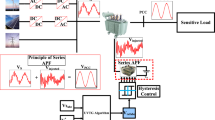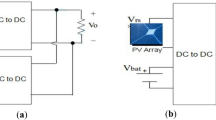Abstract
The newly increased electrical energy is needed around the metropolitan area, and therefore, the transmission system is needed to be reorganized. MVDC (medium voltage direct current) system is an attractive one for constructing these new systems. This MVDC system, which is composed of two or more VSCs (voltage-sourced converters), prevents the degradation of system reliability due to renewable energy resource and is contributed to making it more stable for power supplying companies to supply the electrical power. Furthermore, to connect the increased renewable energy resource with larger capacity into the main grid through this MVDC system, the regulations such as FRT (fault ride through) for the grid have been more and more required. According to the FRT, the VSC system is required to supply the reactive current to grid when the grid voltage drops below the allowed voltage range. However, the FRT operation can cause the DC-link voltage in the MVDC system to increase. If the DC-link voltage exceeds the nominal voltage, the damage to the DC-related application may occur. In this paper, as the method to solve this problem, the application of the APTC (active power tracking control) into the MVDC system was proposed. The APTC is based on the principle that the DC-link voltage is determined by the power balance between the incoming and the outgoing active powers into the DC-link. If the outgoing active power decreases due to the short circuit in grid side, the DC-link voltage rises with the constant incoming active power. However, if the incoming active power is controlled to be reduced by the APTC performance of the MVDC system at the same time, the DC-link voltage is expected to be maintained at a constant level. The effectiveness of the suggested APTC application was verified through the PSCAD (power system computer aided design)/EMTDC (electro magnetic transient design and control) simulation.








Similar content being viewed by others
Change history
10 February 2020
Due to an unfortunate oversight some authors have been omitted during the preparation process. The correct author line is: Sang-Jae Choi, Sung-Hun Lim, Jae-Chul Kim, and Sang-Yun Yun.
10 February 2020
Due to an unfortunate oversight some authors have been omitted during the preparation process. The correct author line is: Sang-Jae Choi, Sung-Hun Lim, Jae-Chul Kim, and Sang-Yun Yun.
References
Crăciun B, Kerekes T, Séra D, Teodorescu R (2012) Overview of recent grid codes for PV power integration. In: 2012 13th International Conference on Optimization of Electrical and Electronic Equipment (OPTIM), Brasov, pp 959–965
van der Meer AA, Ndreko M, Gibescu M, van der Meijden MAMM (2016) The effect of FRT behavior of VSC-HVDC-connected offshore wind power plants on AC/DC system dynamics. IEEE Trans Power Deliv 31(2):878–887
Ndreko M, van der Meer AA, Gibescu M, van der Meijden MAMM (2014) Impact of DC-link voltage control parameters on AC/DC system dynamics under faulted conditions. In: 2014 IEEE PES General Meeting | Conference & Exposition, National Harbor, MD, pp 1–5
Lee Hyeong-Jin, Kim Jin-Su, Kim Jae-Chul (2018) Parameter estimation of chopper resistor in medium-voltage-direct-current during grid fault ride through. Energies 11:3480
Ramtharan G, Arulampalam A, Ekanayake JB, Hughes FM, Jenkins N (2009) Fault ride through of fully rated converter wind turbines with AC and DC transmission systems. IET Renew Power Gener 3:426–438
Pannell G, Zahawi B, Atkinson DJ, Missailidis P (2013) Evaluation of the performance of a DC-link brake chopper as a DFIG low-voltage fault-ride-through device. IEEE Trans Energy Convers 28(3):535–542
Amirnaser Y, Reza I (2010) Votage-sourced converters in power systems : modeling, control, and applications. John Wiley & Sons, New Jersey
Lim ST, Lim LH (2019) Study on operational characteristics of OCR with voltage component in a power distribution system with SFCL. Trans on Electr Electron Mater 20(2):118–123
Author information
Authors and Affiliations
Corresponding author
Additional information
Publisher's Note
Springer Nature remains neutral with regard to jurisdictional claims in published maps and institutional affiliations.
Rights and permissions
About this article
Cite this article
Choi, SJ., Lim, SH. Active Power Tracking Control for DC-Link Voltage Suppression of MVDC System with Voltage-Sourced Converter. J. Electr. Eng. Technol. 15, 287–292 (2020). https://doi.org/10.1007/s42835-019-00313-8
Received:
Revised:
Accepted:
Published:
Issue Date:
DOI: https://doi.org/10.1007/s42835-019-00313-8




